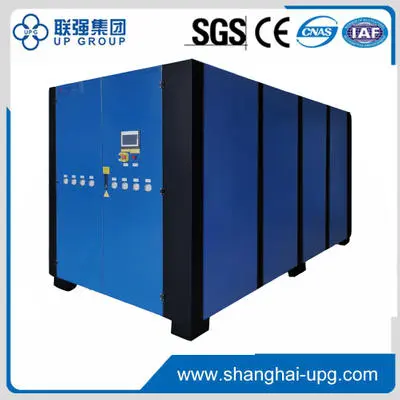A chiller is a mechanical device designed to remove heat from a liquid through a vapour compression or absorption refrigeration cycle. The resulting chilled water is circulated within the building to cool the air or equipment. These units are particularly effective in large-scale applications where conventional air conditioning systems cannot meet the requirements.
The main components of chilled water equipment
Compressor: The heart of the chiller, the compressor increases the pressure of the refrigerant so that it can absorb heat from the water. It compresses the refrigerant gas and raises its temperature and pressure.
Condenser: After the refrigerant leaves the compressor, it enters the condenser and releases the absorbed heat to the external environment. This process changes the refrigerant from a gas back to a liquid.
Expansion valve: The high-pressure liquid refrigerant then passes through the expansion valve with a consequent drop in pressure. The pressure drop cools the refrigerant significantly.
Evaporator: In the evaporator, the low-pressure refrigerant absorbs heat from the chilled water, causing the refrigerant to evaporate and turn back into a gas. This is where the water actually cools.
Chilled Water Pump: This component circulates the chilled water throughout the building or facility, ensuring that the chilled water reaches the areas needed for effective temperature control.
Please refer to our company’s this product, LQ Box Type (Module) Water Chiller Unit
Box type (module) water chiller unit economy and steadily: refrigeration compressor adopts the imported famous brand totally enclosed type compressor. Box type (module) water chiller unit is of small noise, high efficiency, and it contains the efficient heat exchange copper tube, import refrigeration valve parts. Box type (module) water chiller unit makes the chiller to be used for a long time and run steadily.

How do chilled water units work?
The operation of a chiller unit can be broken down into several key steps:
Heat absorption: The process begins with the evaporator, where warm water from the building is pumped into the evaporator. As the water flows through the evaporator, it transfers heat to the low-pressure refrigerant, which absorbs the heat and evaporates into a gas.
Compression: The gaseous refrigerant is then sucked into the compressor, where it is compressed, thereby increasing its pressure and temperature. This high pressure gas can now release the heat it has absorbed.
Heat removal: The hot, high-pressure refrigerant gas moves to the condenser, where the refrigerant releases heat to the outside air or water, depending on the type of condenser used (air-cooled or water-cooled). The refrigerant loses its heat and condenses into a liquid state.
Pressure reduction: The high-pressure liquid refrigerant then flows through an expansion valve, which reduces the pressure of the refrigerant and cools it significantly.
Repeat cycle: The low pressure cold refrigerant re-enters the evaporator and the cycle begins again. The cooled chilled water is recycled back into the building to absorb more heat.
Next and you introduce the application of chilled water unit
Chilled water units are versatile and can be used in a variety of applications:
Commercial buildings: in office buildings, shopping centres and hotels, chiller units provide efficient cooling for large spaces to ensure comfortable living.
Industrial processes: Many manufacturing processes require precise temperature control. Chillers are used to cool machines, maintain product quality and improve operational efficiency.
Data centres: Data centres generate a lot of heat as the demand for data processing continues to grow. Chillers help keep servers and other critical equipment at optimal temperatures.
Medical Facilities: Hospitals and clinics rely on chillers to provide comfort for patients and staff and to support sensitive medical equipment.
Benefits of Using Chillers
Energy Efficiency: Chillers are designed to operate efficiently and typically use less energy than traditional air conditioning systems, especially in larger applications.
Scalability: These units can be easily expanded to meet the cooling needs of a wide range of applications, making them suitable for both small and large installations.
Long service life: With proper maintenance, chillers have a long service life and can continue to provide reliable cooling for many years,
Environmental impact: Many modern chilled water units use environmentally friendly refrigerants and technologies, reducing their impact on the environment.
In conclusion, understanding how chilled water units work is vital for anyone involved with HVAC systems, whether it be installation, maintenance or operation. These units are integral to providing efficient cooling solutions for applications ranging from commercial buildings to industrial processes. Please contact our company if you have any requirements about the chillers, our company equipped with experienced engineer and sales.
Post time: Oct-10-2024

